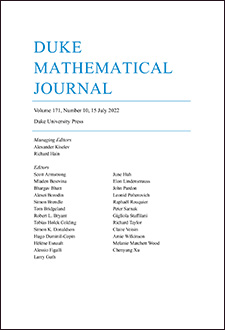Abstract
We estimate the sums and where denotes the von Mangoldt function (and the Möbius function) whenever and are two coprime bases, (resp., ) is a strongly -multiplicative (resp., strongly -multiplicative) function of modulus , and is a real number. The goal of this work is to introduce a new approach to study these sums involving simultaneously two different bases combining Fourier analysis, Diophantine approximation, and combinatorial arguments. We deduce from these estimates a prime number theorem (and Möbius orthogonality) for sequences of integers with digit properties in two coprime bases.
Citation
Michael Drmota. Christian Mauduit. Joël Rivat. "Prime numbers in two bases." Duke Math. J. 169 (10) 1809 - 1876, 15 July 2020. https://doi.org/10.1215/00127094-2019-0083
Information





